Handwriting and Fine motor skills involve the use of the smaller muscle of the hands, commonly in activities like using pencils, scissors, construction with bricks, doing up buttons and opening lunch boxes.
Fine motor skill efficiency significantly influences the quality of the task outcome as well as the speed of task performance. Efficient fine motor skills require a number of independent skills to work together to appropriately manipulate the object or perform the task.
Why are fine motor skills important?
Fine motor skills are essential for performing everyday skills as outlined above as well academic skills. Without the ability to complete these everyday tasks, a child’s self-esteem can suffer, their academic performance is compromised and their play options are very limited. They are also unable to develop appropriate independence in ‘life’ skills (such as getting dressed and feeding themselves) which in turn has social implications not only within the family but also within peer relationships.
How can you tell if a child has fine motor skill difficulties at a glance?
- Avoidance and/or disinterest of fiddly finger skills
- Preferring physical activity (again to avoid sit down tasks)
- Interest in ‘passive’ activities such as IT (e.g. watching TV an IPAD that don’t require Fine Motor skills)
- No interest in pencil or scissors skills
- Being ‘bossy’ in play and asking others to “draw a cat for me”
- Not persisting in the face of a challenge (e.g. asking parents to fix a problem without physically trying to fix it themselves)
- Waiting for parents to dress them or clean their teeth rather than trying themselves
Before looking at the below activities it may be a good idea to review the child's posture and seating.
 The midline is an imaginary line running down the middle of the body dividing the body into halves (left and right).
The midline is an imaginary line running down the middle of the body dividing the body into halves (left and right).
Crossing the midline is where the movement of a body part crosses over the midline from one side to the other side of the body to complete a task.
Crossing of the body midline begins as early as infancy, when a baby reaches out with both hands to grasp a large object. This could be for a ball that is positioned slightly to one side of their body, the baby will end up crossing the midline to reach and take hold of the ball.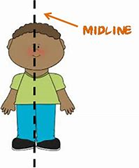
The automatic crossing of the midline is required for mature and complex movements. The child who has difficulties with midline crossing will lean over to the right or left when writing on that side rather than rotate their upper body.
Children may tend to use the left hand on the left side of the body and the right hand on the right side of the body as they play. Initially this could be the hand closer to the object. However, over time they develop the skills to use both sides of their body simultaneously. This could mean when both sides are doing the same thing i.e. when using a rolling pin or when one side is doing one movement and the opposite side is doing another for example one hand could be using a pen or a pair of scissors whilst the hand holding/turning the paper.
 Bilateral integration is also an important factor in helping a child develop the skill of crossing the midline.
Bilateral integration is also an important factor in helping a child develop the skill of crossing the midline.
Please see the below links for some helpful activities
Bilateral hand skills for preschool and older children
Shoulder stability is the ability of the surrounding muscles to support the shoulder and allows for accurate hand functions. This develops from an early age as a baby lies on their tummy and takes weight through their arms and will continue to develop as they begin to crawl.
 Shoulder stability is an important developmental milestone for children who are learning to colour and write. When toddlers start to scribble they start by using their whole arm. Then, as the child progresses developmentally, they begin to rest their forearm on the table. This helps them to start using their hand and fingers (instead of their shoulder and arm) to control the crayon.
Shoulder stability is an important developmental milestone for children who are learning to colour and write. When toddlers start to scribble they start by using their whole arm. Then, as the child progresses developmentally, they begin to rest their forearm on the table. This helps them to start using their hand and fingers (instead of their shoulder and arm) to control the crayon.
Good shoulder stability can make it easier to control the smaller movements of the hands and fingers.
Babies who don’t crawl or don’t crawl for very long or can’t tolerate “tummy time” can often be delayed in developing shoulder stability. This makes it harder for them to learn how to write and they may complain that they are too tired or that their arm hurts when writing. This is because they are using their entire arm to try to make a tiny letter, which is very hard work.
Children with delayed or poor shoulder stability, you may also find it hard to use scissors, have poor dressing skills and struggle to use items such as cutlery.
An infant will initially hold objects within the palm of their hands after being raked into the palm by the fingers. They will then develop on to picking up and holding objects in a pincer grasp. The development of grasp is influenced by a child’s growing interest in objects and desire to hold them.
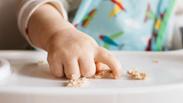 The pincer grasp is defined as a grasp that uses the pads then tips of the index finger and thumb to pick up and grasp objects. You will start to see this grasp the most as a baby masters feeding itself and can pick up smaller pieces of food such as circle cereal with their fingers instead of the palm of their hand.
The pincer grasp is defined as a grasp that uses the pads then tips of the index finger and thumb to pick up and grasp objects. You will start to see this grasp the most as a baby masters feeding itself and can pick up smaller pieces of food such as circle cereal with their fingers instead of the palm of their hand.
While it may seem like second nature to an adult, to a baby this is an important milestone in fine motor development. The pincer grasp represents the coordination of brain and muscles that’s necessary to help them gain increasing independence.
A baby will typically develop this skill between the ages of 9 and 10 months, although this can vary. Children develop at different rates.
The pincer grasp is an essential grasp to develop as it allows for more refined control as over time the child will be using a pincer grasp for important tasks such as holding a pen/pencil, using cutlery, buttons, zips.
Handwriting is a complex skill to learn and starts well before a child is ready to pick up a pencil and make marks on paper. When a baby starts reaching for their toys and begins to crawl, they are developing the postural stability and visual motor skills needed for when they start to begin to write.
Handwriting is such an important skill to have even with the ever increasing use of computers in schools. So making sure your child has the necessary building blocks in place is essential.
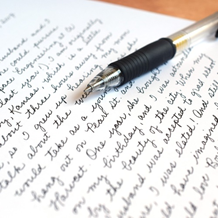 Having a solid fine and gross motor skills base is important. A significant fine motor skill for your child to have for handwriting is good in-hand manipulation, the skill of picking up an item and being able to move it around in your hand, or manipulate it, this involves the coordination of small muscles and movements of the hands, fingers, and eyes. Whilst for gross motor skills having good core and shoulder strength to maintain a good posture and balance is equally as significant.
Having a solid fine and gross motor skills base is important. A significant fine motor skill for your child to have for handwriting is good in-hand manipulation, the skill of picking up an item and being able to move it around in your hand, or manipulate it, this involves the coordination of small muscles and movements of the hands, fingers, and eyes. Whilst for gross motor skills having good core and shoulder strength to maintain a good posture and balance is equally as significant.
As well has having a solid fine and gross motor base there are many other skills involved in handwriting. Listed below are some of the more complex skills needed to develop good handwriting:
- Visual perceptual and Visual motor skills - The brain’s ability to interpret and make sense of visual images seen by the eyes (perception) and respond with a motor act
- Visual Processing Skills - The perceptual skills of knowing the difference between different shapes and forms/letters
- Sitting correctly/Sitting posture – This area is very important
- Hand eye co-ordination - Tracking the movement of the hand, pencil and paper
- Crossing midline skills - The ability to cross the imaginary line running from a person’s nose to pelvis that divides the body into left and right sides
- Bilateral coordination skills – Being able to ordinate both sides of your body for effective posture, holding the paper, moving the pencil etc.
- Letter formation
- Pencil grasp and pressure
- Pencil control and fluency of movement
All these skills and strengths are learnt and developed in stages as a child grows. A weakness in any of these areas can affect a child’s handwriting skills.
A good pencil grasp/grip is one which allows the child to keep the wrist steady and make small movements of the fingers to move the pen tip in different direction to create short straight and curved lines. Also to be able to complete a piece of writing/drawing neatly and without getting tired. An immature or poor pencil grip tends to block the finger movements, and the movements to form letters will come from the wrist and/or the arm instead. This can lead to pain and fatigue.
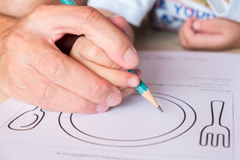 There are different pencil grasps has shown in the resources below but one that is deemed most effective is the tripod grasp, where the thumb, index and middle fingers are holding the pencil. There are some variations this grasp which have been found to be almost equally efficient. If a grasp enables the writing to be legible and efficient, it is considered functional.
There are different pencil grasps has shown in the resources below but one that is deemed most effective is the tripod grasp, where the thumb, index and middle fingers are holding the pencil. There are some variations this grasp which have been found to be almost equally efficient. If a grasp enables the writing to be legible and efficient, it is considered functional.
Pre-writing skills are the underlying skills children need to develop before they are able to write. Many children develop these skills naturally through play.
Early development such as tummy time, rolling, crawling, standing all naturally help your child gain good core strength which will progress to help them sit upright, have strong neck to hold the head upright, strong shoulders to facilitate arm and wrist movements and strong hand/finger strength to grasp objects. These skills also contribute to the child’s ability to hold and use a pencil, and the ability to draw, write, copy, and colour later on.
 Pre-writing skills are the lines and strokes (pre-writing shapes) your child needs to master before learning how to write the alphabet. These are the pencil strokes that most letters, numbers and early drawings are made up of. They are typically mastered in sequential order, and to an age specific level. These strokes include the following strokes: |, —, O, +, /, square, \, X, and Δ.
Pre-writing skills are the lines and strokes (pre-writing shapes) your child needs to master before learning how to write the alphabet. These are the pencil strokes that most letters, numbers and early drawings are made up of. They are typically mastered in sequential order, and to an age specific level. These strokes include the following strokes: |, —, O, +, /, square, \, X, and Δ.
To help your child be able to establish the pre-writing shapes and develop the pencil control/fluency they will also need to develop the skills of crossing the mid-line which is the ability to cross the imaginary line running from a person’s nose to pelvis that divides the body into left and right sides. Start working on their pencil grasp, have hand eye co-ordination, bilateral integration which is being able to use two hands together such as one hand holding the paper and the other holding the pen, working towards a hand dominance and visual perception the brain’s ability to interpret and make sense of visual images seen by the eyes.
Pre-writing skills are essential for the child to be able to develop the ability to hold and move a pencil fluently and effectively and therefore produce legible writing.To help your child develop the pre-writing skills and shapes please see the handouts below:
Cutting skills take time for children to develop and learning to use them in a controlled way takes lots of practice. Children may have the skills to use small scissors by three to four but scissor skills are not fully developed until around 6 years of age.
Your child will be ready to start using scissors when they have a good sitting balance, hand strength and dexterity, hand-eye coordination, attention and an interest in using them.
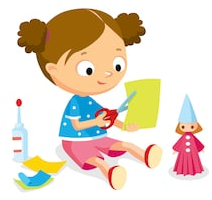 A good way to teach your child to hold a pair of scissors is to put the index finger in front as this helps to give good scissor control and guide the way. The middle finger will then go in one of the loops with the thumb in the other. This grip also helps strengthens the same muscles that you child needs for writing and drawing.
A good way to teach your child to hold a pair of scissors is to put the index finger in front as this helps to give good scissor control and guide the way. The middle finger will then go in one of the loops with the thumb in the other. This grip also helps strengthens the same muscles that you child needs for writing and drawing.
Also encourage your child to keep both thumbs on top, the thumb on the scissor hand and the thumb on the hand that his holding the paper, these should both be facing towards the ceiling. Getting your child to do the ‘thumbs up’ sign before starting can help them remember this.
Getting your child to hold a piece of paper between their elbow and the side of their body and keeping it there whilst they are cutting helps to keep their hand and arm in the correct position.
When first starting to cut use stiff material such as card or straws as this is easier for your child to cut than paper or flimsy material. Get your child to practice single snips before moving on to continuous cutting.
Dressing may seem a simple task, but it is actually a complex activity that requires multiple skills for a child to be able to dress and undress successfully.
Children learn and develop these skills but they may also need help to build these skills and are/or modify dressing tasks for them to be more independent and successful.
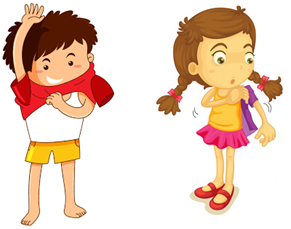 Included in the skills that they will learn and develop and need for dressing are fine and gross motor skills, being able move their body and limbs in a range of movements. As well as able to reach, grasp and release objects in order to undertake buttons or holding and holding items of clothing.
Included in the skills that they will learn and develop and need for dressing are fine and gross motor skills, being able move their body and limbs in a range of movements. As well as able to reach, grasp and release objects in order to undertake buttons or holding and holding items of clothing.
Your child will also need to build up a sense of balance and be able to maintain this whilst changing posture/positions and co-ordination skills to be able to use both arms together, separately and crossing over the midline.
Motor planning is another skill that is needed in order for a child to know how to put on an item of clothing on and what comes next. As well as having good body awareness as to where their own boy is in space.
The first dressing stage is usually shown by the child being seen to hold out their arms and legs to put through items of clothing, such as putting their arms through a coat sleeve or a foot out for a shoe.
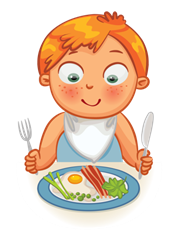 Children develop their feeding skills starting with finger feeding moving on to spoon feeding and then progressing to cutlery. Self-feeding is a very complex task and it is common for children to have difficulty using cutlery to feed themselves and takes practise.
Children develop their feeding skills starting with finger feeding moving on to spoon feeding and then progressing to cutlery. Self-feeding is a very complex task and it is common for children to have difficulty using cutlery to feed themselves and takes practise.
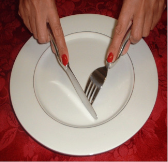 When teaching a child to use cutlery it is firstly important that they are well positioned when sat at a table with their feet on the floor or supported so that they can use their hands freely.
When teaching a child to use cutlery it is firstly important that they are well positioned when sat at a table with their feet on the floor or supported so that they can use their hands freely.
It is easier for children to start off using chunky cutlery. A good way to teach them to hold the cutlery is by getting them to rest their index fingers along the top of the cutlery. A general rule is that the child holds the knife in their dominant hand. They may benefit from hand over hand support to get this right. Teach your child to stab the food with the fork to hold it still, place the knife in front of the fork and with a sawing action cut the food. It usually takes until a child is 7 years old before you can successfully use cutlery to feed themselves without getting too messy.
 Below are activities to help your child develop cutlery skills.
Below are activities to help your child develop cutlery skills.
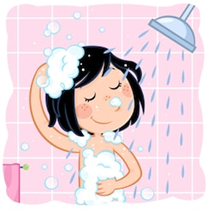 When you stop and think about bathing / showering/hair brushing/ teeth brushing, the skills that are required to do these tasks independently are quite extensive and involve fine motor, gross motor, sensory processing, organisational skills and visual perceptual skills. Children generally start off by being bathed by their parents and hopefully learn to enjoy bath times through these experiences.
When you stop and think about bathing / showering/hair brushing/ teeth brushing, the skills that are required to do these tasks independently are quite extensive and involve fine motor, gross motor, sensory processing, organisational skills and visual perceptual skills. Children generally start off by being bathed by their parents and hopefully learn to enjoy bath times through these experiences.
You will gradually then see your child wanting to help wash themselves by using their hands and then moving on to washing themselves with a cloth. They will then progress to wanting to do more specific tasks such as washing their hands at the sink and begin to brush their teeth and brushing their hair all with assistance/supervision to start with. Through practicing these tasks they will start to become more independent and may only need prompting to help them with these activities, however supervision may still be needed for safety reasons.
 In order to for children to accomplish independence with bathing/grooming, breaking the skills down into a step by step analysis can be beneficial to determine where certain skills need to be practiced or modified. Also as your child grows older they may become more interested in how they look and may want to take more care with their bathing/grooming activities and begin to want to shower daily, use deodorant etc. and this interest also helps them to become independent in these skills It is important to remember that all children develop at different rates and is also dependent upon sensory and motor functioning as well as cognitive abilities. They may also resist these activities due to sensory or motor difficulties
In order to for children to accomplish independence with bathing/grooming, breaking the skills down into a step by step analysis can be beneficial to determine where certain skills need to be practiced or modified. Also as your child grows older they may become more interested in how they look and may want to take more care with their bathing/grooming activities and begin to want to shower daily, use deodorant etc. and this interest also helps them to become independent in these skills It is important to remember that all children develop at different rates and is also dependent upon sensory and motor functioning as well as cognitive abilities. They may also resist these activities due to sensory or motor difficulties
Some strategies to help to develop these skills and to help overcome any difficulties in these areas can be found below: